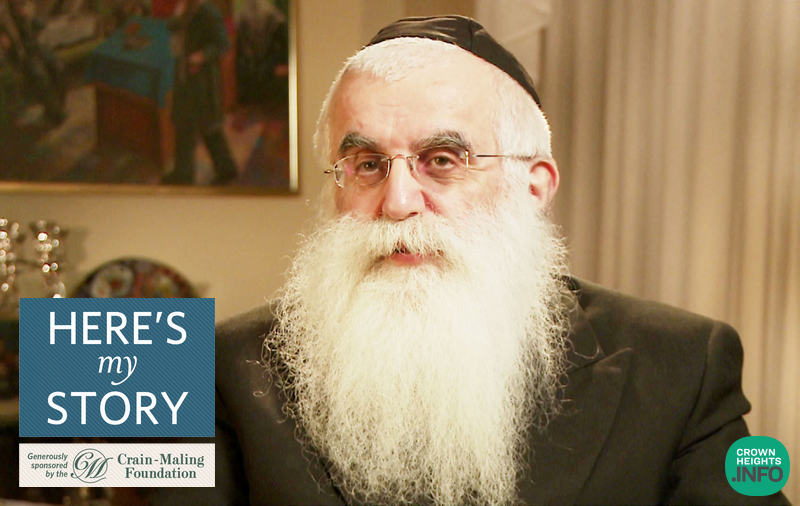
Here’s My Story: One Song in Fifteen Languages (Audio of Song Included)
Rabbi Yosef Minkowitz
Click here for a PDF version of this edition of Here’s My Story, or visit the My Encounter Blog.
In 1953, most Lubavitchers in North America lived in Brooklyn; not in Crown Heights, but in Brownsville. That was when my family moved there as well, from Paris, where I was born following the Second World War.
On Shabbat, we would walk half an hour to be with the Rebbe for the prayers and chasidic gatherings – farbrengens. In those days, the Rebbe’s farbrengens were short, less than two hours, and they took place in what is today the upstairs small synagogue in 770.
The platform that the Rebbe sat on during the farbrengens was a piece of plywood on top of a few milk crates, placed against the southern wall of the room. In front of the Rebbe were two rows of two tables, where a total of forty people sat, with more people standing around; in all, there were maybe one hundred and fifty people squashed into the room.
Directly across from the Rebbe there was a table where all the children under Bar Mitzvah would stand. We didn’t understand much of what the Rebbe was saying, but we could still see the Rebbe and participate in the event.
Unlike adults, who were able to have an audience with the Rebbe in honor of their birthdays, children couldn’t have their own private yechidus, as these audiences are called. But once a year, at the farbrengen preceding an upcoming birthday, we could push through the crowd onto the platform and tell the Rebbe: “This Thursday is my birthday.”
The Rebbe would give the child a blessing and say l’chaim. It didn’t take much time, but every kid was able to have his special moment with the Rebbe.
In contrast to later years, the farbrengens had an intimate atmosphere. For example, the Rebbe would tell an individual: “You had a baby, say l’chaim!”, “You moved in to a new home, say l’chaim!” and the Rebbe would give him a blessing.
Toward the end of the event, as the Rebbe prepared to leave, the kids would run out of the room, and stand in a semi-circle in front of the Rebbe’s office, singing the last song sung at the farbrengen.
As the Rebbe would approach, he would motion with his hand to encourage our singing, and he would stay with us for a few moments before going into his office. It was like our own private mini-farbrengen!
Over time, the population grew and the room became too small, so the farbrengens moved into the courtyard of 770, until the building was expanded in 1960.
After one farbrengen on a hot summer day in the early ‘60s, I was walking back home from 770 together with my mother. Up ahead, we noticed the Rebbe’s mother, Rebbetzin Chana Schneerson, standing on Kingston Avenue, on the corner of President Street.
“Gut Shabbos,” my mother greeted her.
“Was the air conditioner working in 770 today? Was it hot inside?” Rebbetzin Chana asked. With the expansion of the synagogue, air conditioning had been installed but it didn’t always work well.
“It felt fine,” my mother replied.
“You know why I’m asking,” offered Rebbetzin Chana. “I have a relative there.” She was smiling as she said it; she always had a good sense of humor.
There were other times, outside of the farbrengens, that the Rebbe interacted with the children. One time, on a Shabbat, as the Rebbe came out of the courtyard-synagogue, he spotted me and a friend building a “pyramid” out of some rented folding chairs, on the driveway to the courtyard.
“You are outside of the eruv,” the Rebbe remarked. We were maybe eight years old, so I ran to my father to ask what an eruv is. It turned out that there was a string over the courtyard entrance that made it permissible to carry within that area on Shabbat – and we had strayed out beyond it.
In 1956, we had another interesting farbrengen experience. In those days there was a chasid named Rabbi Uriel Tzimmer. Hailing from the Hungarian community, he was a highly intelligent person, as well as being a prolific writer, who took quite a zealous stance on some of the religious questions of the day. Although he had originally come from a different community, he became quite close with the Rebbe and even helped write up the first two volumes of Likkutei Sichot, a collection of the Rebbe’s talks.
That year, Simchat Torah was on a Friday, which meant that the Simchat Torah farbrengen – which in other years would last for many hours – was quite short. Consequently, there were two farbrengens the next day: One in the early afternoon, as usual for the last Shabbat of every month, and an additional, later farbrengen, in order to make up for Simchat Torah, which lasted for many hours through the night and into early the next morning.
Earlier on Shabbat, the Rebbe’s chief secretary, Rabbi Hodakov, had gone over to Uriel Tzimmer with a request: A few weeks ago, after coming back from the newly established Camp Gan Israel, the returning campers had prayed the afternoon service with the Rebbe. During that time the Rebbe had heard them singing a song they had learned at camp, and now he wanted them to sing it at the farbrengen that evening.
The song originated in Jerusalem, based on the prayer Ha’aderet VeHa’emunah, “The Glory and the Faith.” A leader sings each line of praise, and then asks where to direct this praise: “To whom? To whom?” At this the crowd responds: “To the Life of All the Worlds! / Who is He, and which is He? / This is my G-d and I will glorify Him!”
In camp, the children had learned to sing the “To whom” part of the chorus in Hebrew and English, in addition to the traditional Yiddish. Now, the Rebbe wanted Uriel Tzimmer to lead the singing, using all of the languages he knew. This was because Uriel Tzimmer, who had actually worked as a translator in the United Nations, spoke quite a few languages.
And so, that evening Uriel Tzimmer led the children in singing this song in French, Russian, German, Spanish, Portuguese, Czech, Polish, Arabic, Turkish, Italian, Dutch, Hungarian – aside from the languages the children had already learned, and maybe a few more. There were around fifteen kids, and we were the choir, singing the Hebrew refrain in response to all of these languages. The Rebbe sang along with us, waving his hands in encouragement all the while. The Rebbe then asked the elder chasid, Reb Zalman Duchman, to recite “Hamalach Hagoel,” the blessing our forefather Jacob gave to his grandchildren, and then sent cake to be distributed to the children.
It’s a memory I can never forget!
As is documented in the published account of this farbrengen, the Rebbe then went on to dedicate a few words to the children. The lyrics “This is my G-d and I will glorify Him” come from the song the Jewish people sang at the Splitting of the Sea. Our sages say that they all saw G-d in those moments, but it was the children who “perceived Him first.” The same, said the Rebbe, will be true of the future redemption: “The children born in the throes of this bitter exile, in utter darkness…they will be the ones to ‘perceive Him first.’”
The Rebbe concluded: “At a time when so much is concealed and unclear, these children are not fazed…from them will grow the generation of redemption.”
Rabbi Yosef Minkowitz serves as the principal/dean of the Beth Rivkah Academy in Montreal, where he has been since 1973. He was interviewed in January of 2011 and February of 2020.















